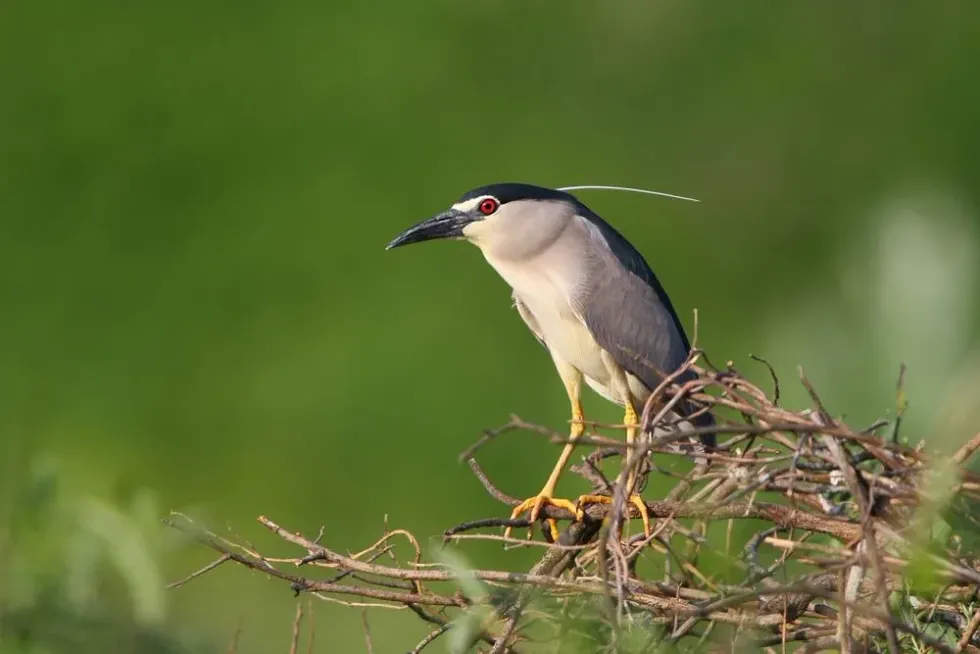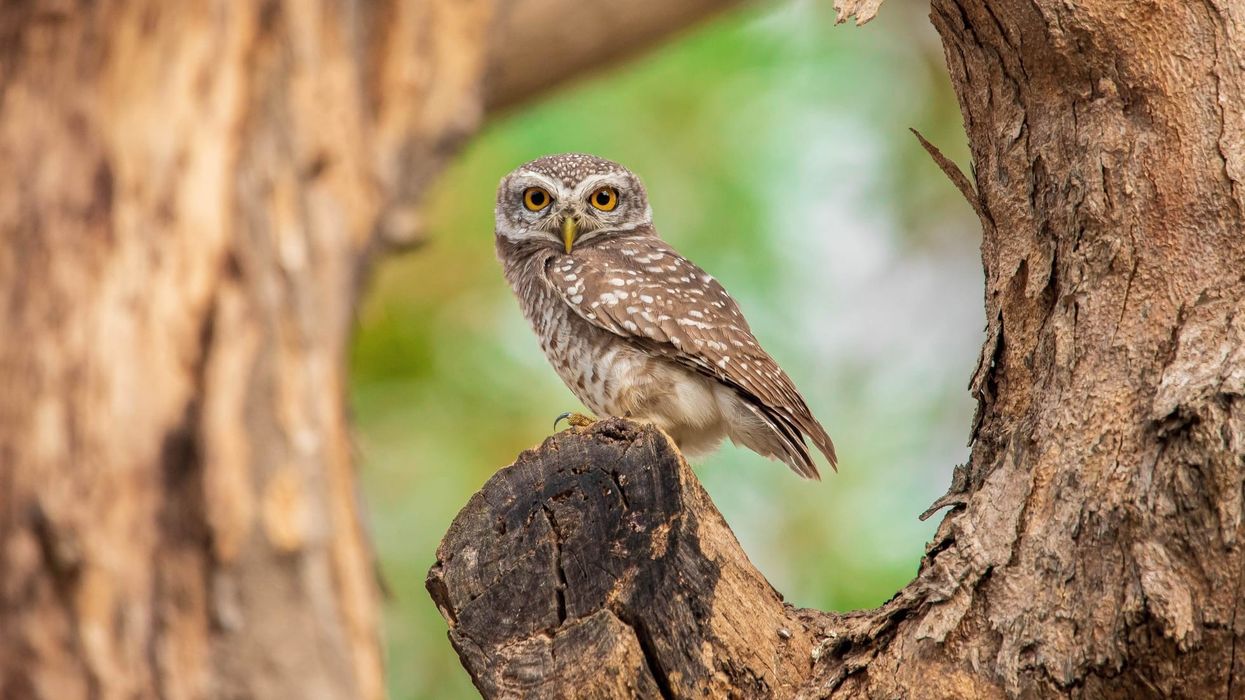Black crowned night herons (Nycticorax) are carnivorous aves. They can mostly be found near water bodies or marshes in order to prey on fishes.
The nesting habits of a black crowned night heron are arboreal, and their nests can be found on trees. Night herons do not stab their prey with their long and pointed beaks but instead catch the fish in their gills.
Both the male and the female night herons guard their nest. While the young ones leave the nest one month after birth, they are unable to fly for another couple of weeks.
The black crowned night heron nests colonially, and many nests can be found on the tree-tops of a single tree. After reading about these birds, you may also look at bird of paradise facts and barn owl facts.
Night Heron Interesting Facts
What type of animal is a night heron?
The black crowned night heron (Nycticorax) is a bird. The night heron is a nocturnal bird and hunts its prey during the night. It is an ambush predator that kills marine fishes by stalking and standing near the water edge. Some species of night herons also hunt during the evening or early morning.
What class of animal does a night heron belong to?
The black crowned night heron is a bird that is commonly found in Europe, Asia, and Africa. They are medium sized herons and have a body length of 22.8-26 in (57.9-66 cm).
There are several species of the night heron like the Nankeen night heron, yellow crowned night heron, black crowned night heron, white backed night heron, Malayan night heron and Japanese night heron.
How many night herons are there in the world?
In the African continent, during the winter season, an approximate number of 70,000 to 1,00,000 black crowned night heron can be found. In continents such as Asia and Europe, a stable number of night herons are found. The population of night herons is decreasing in recent years due to deforestation and other human activities.
Where does a night heron live?
Black crowned night herons can be found in the woods, tropical rainforest, wetlands, thickets, mangrove forests, and the edges of a lagoon. Night heron habitat in multiple locations. Black crowned night herons are typically migratory and can sustain in extremely cold weather.
What is a night heron's habitat?
Black crowned night herons have the maximum potential for adaptability and can live in multiple habitats. Night herons can live in both warm and cold climates. They are found anywhere near water bodies as their diet mostly comprises of marine fishes and mammals. They can be found near swamps, marshes, rivers, lakes, ponds, canals, reservoirs and wet crop fields.
Who do night herons live with?
Night herons sometimes nest alone but they generally nest in groups. Multiple nests of the black crowned night heron can be found on a single tree. They only exhibit their solitary nature while hunting for food. They are very social and live within groups. They also build their colonies with egrets.
How long does a night heron live?
The average lifespan of a black crowned night heron is three years. They cannot live for more than three years, and are often predated before that. These species are often killed due to nickel poisoning and by getting tangled in fishing nets. Their population is also decreasing due to the clearing of forest land.
How do they reproduce?
Though night herons breed throughout the year, most of the breeding activity has been recorded during spring and late summer. These species of aves mate near their nests.
The males attract the females by performing various acts. At first, the black crowned night heron female is rejected by the displaying male, but is later allowed to enter his territory for mating. After a pair is formed, the legs of the male and the female turn pink showing sexual readiness.
The black crowned night herons mate a day or two after the pair is established. The young birds, upon birth, leave the nest within one month, although they are unable to fly.
What is their conservation status?
The conservation status of black crowned night herons as listed by the IUCN is of the Least Concern, but an evident decrease in population is recorded. Some species of the black crowned night heron (Nycticorax) are also listed as Endangered species. But the overall population of night herons is stable.
Night Heron Fun Facts
What do night herons look like?
Adult herons have a black crown with white or gray on the remaining half of the body and short yellow legs. Black crowned night herons have pale gray wings and white underparts.
The bills of the black crowned night heron are pointed. The feathers are broad and round. During their flight, the legs of the night heron will reach the end of their tail.
How cute are they?
Black crowned night herons are not very cute, but they have an attractive appearance even if they are not very colorful. Their black crown and gray plumage with red eyes make them look fierce. Other species of the night heron, like the green or great blue heron are both commonly found in North America.
How do they communicate?
Night herons communicate by uttering distinct sounds. Male night herons also communicate through different displays in order to try attracting females for mating. They also emit barking calls when disturbed. Other calls are also used for communication with juveniles and adults.
How big is a night heron?
The average weight of a black crowned night heron is 1.6-2.2 lb (25.6-35.8 oz). When compared to a blue heron in terms of size, the smaller one is the black crowned night heron. Black crowned night herons have an average length of 22.8-26 in (57.9-66 cm). They are physically dimorphic, with females being slightly smaller than males.
How fast can a night heron fly?
Black crowned night herons can fly at a speed of 35 mph (56 kmph). Baby night herons learn to fly when they complete six weeks of their lifespan. During the winter season, babies usually stay in their nests and do not fly. The young black crowned night herons are catered to by their parents when the climate gets cold.
How much does a night heron weigh?
1.6-2.2 lb (25.6-35.8 oz) is the average mass of an adult black crowned night heron. Black crowned night herons are much lighter in weight when compared to the great blue heron.
What are the male and female names of the species?
There are no different names for the male and female species of night heron.
What would you call a baby night heron?
Young black crowned night herons are generally called chicks or juveniles. They do not have a specific scientific name.
What do they eat?
Black crowned night herons use their bill to feed themselves. Their diet includes anything which can be swallowed.
They like to feed on marine fishes such as clams, crayfish and mussels as their staple diet. They also feed on turtles, lizards, worms, earthworms, rodents, eggs and small birds. They are carnivorous in nature and kill their prey by carrying them in their bill.
Are they dangerous?
Black crowned night herons are not dangerous. Only the great blue heron is capable of attacking a human being if threatened or provoked. The black crowned night heron does not pose any threat to human beings.
Would they make a good pet?
No, black crowned night herons would not make good pets as they are very social and like living with their colonies and other species of egrets. They would die sooner if caged and solitary.
Did you know...
The black crowned night heron is known as the quark bird for the calls it emits while in flight. Night herons use the technique of bill vibrating, which is opening and closing their bills in a fast motion to disturb still water and catch their prey after its movement.
Black crowned night herons cannot differentiate between eggs of ibises and egrets, which are common members of their colony and will incubate any eggs placed in their nest.
Why are they called night herons?
The genera Nycticorax means night raven, which refers to the night hunting and the crow-like calls the bird utters.
How many eggs does a yellow crowned night heron lay?
The yellow crested night heron lays two to six eggs per clutch.
What is the long hair on the back of the black crowned night heron?
White plumes grow from the head to the back of the night heron which is used for attracting mates during the breeding season and to display various acts.
Here at Kidadl, we have carefully created lots of interesting family-friendly animal facts for everyone to discover! Learn more about some other birds including secretary bird, or great green macaw.
You can even occupy yourself at home by drawing one of our night heron coloring pages.










